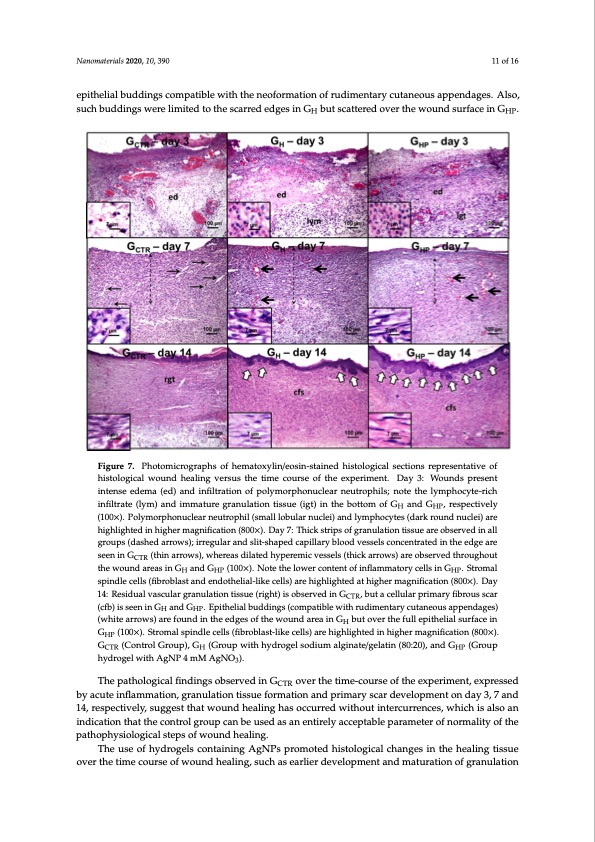
PDF Publication Title:
Text from PDF Page: 011
(chronic inflammation). The stromal spindle cells, interpreted as fibroblasts and endothelial cells, were densely dispersed throughout the wound area and arranged parallel to the wound surface. Most vessels were widely dilated and hyperemic. In GHP, the granulation tissue had more mature morphological features, such as reduction of the inflammatory response, higher content of hyperemic blood vessels, and more intense proliferation of fibroblast-like spindle cells. Nanomaterials 2020, 10, 390 11 of 16 On day 14, there was the persistence of vascular granulation tissue in GCTR, whereas GH and GHP presented a cellular fibrous scar. All groups exhibited full epithelization, but only GH and GHP showed epithelial buddings compatible with the neoformation of rudimentary cutaneous appendages. Also, epithelial buddings compatible with the neoformation of rudimentary cutaneous appendages. Also, suchbuddiingswerelliimiittedttotthesscarrredeedgeessiinGH butscatteredoverthewoundsurfaceiinGHP. H HP Figure 7. Photomicrographs of hematoxylin/eosin-stained histological sections representative of histological wound healing versus the time course of the experiment. Day 3: Wounds present intense edema (ed) and infiltration of polymorphonuclear neutrophils; note the lymphocyte-rich infiltrate (lym) and immature granulation tissue (igt) in the bottom of GH and GHP, respectively (100×). Polymorphonuclear neutrophil (small lobular nuclei) and lymphocytes (dark round nuclei) are highlighted in higher magnification (800×). Day 7: Thick strips of granulation tissue are observed in all groups (dashed arrows); irregular and slit-shaped capillary blood vessels concentrated in the edge are seen in GCTR (thin arrows), whereas dilated hyperemic vessels (thick arrows) are observed throughout the wound areas in GH and GHP (100×). Note the lower content of inflammatory cells in GHP. Stromal spindle cells (fibroblast and endothelial-like cells) are highlighted at higher magnification (800×). Day 14: Residual vascular granulation tissue (right) is observed in GCTR, but a cellular primary fibrous scar (cfb) is seen in GH and GHP. Epithelial buddings (compatible with rudimentary cutaneous appendages) (white arrows) are found in the edges of the wound area in GH but over the full epithelial surface in GHP (100×). Stromal spindle cells (fibroblast-like cells) are highlighted in higher magnification (800×). GCTR (Control Group), GH (Group with hydrogel sodium alginate/gelatin (80:20), and GHP (Group hydrogel with AgNP 4 mM AgNO3). The pathological findings observed in GCTR over the time-course of the experiment, expressed by acute inflammation, granulation tissue formation and primary scar development on day 3, 7 and 14, respectively, suggest that wound healing has occurred without intercurrences, which is also an indication that the control group can be used as an entirely acceptable parameter of normality of the pathophysiological steps of wound healing. The use of hydrogels containing AgNPs promoted histological changes in the healing tissue over the time course of wound healing, such as earlier development and maturation of granulationPDF Image | Wound Healing Silver Nanoparticles-Composing Hydrogel

PDF Search Title:
Wound Healing Silver Nanoparticles-Composing HydrogelOriginal File Name Searched:
nanomaterials-10-00390-v2.pdfDIY PDF Search: Google It | Yahoo | Bing
Turbine and System Plans CAD CAM: Special for this month, any plans are $10,000 for complete Cad/Cam blueprints. License is for one build. Try before you buy a production license. More Info
Waste Heat Power Technology: Organic Rankine Cycle uses waste heat to make electricity, shaft horsepower and cooling. More Info
All Turbine and System Products: Infinity Turbine ORD systems, turbine generator sets, build plans and more to use your waste heat from 30C to 100C. More Info
CO2 Phase Change Demonstrator: CO2 goes supercritical at 30 C. This is a experimental platform which you can use to demonstrate phase change with low heat. Includes integration area for small CO2 turbine, static generator, and more. This can also be used for a GTL Gas to Liquids experimental platform. More Info
Introducing the Infinity Turbine Products Infinity Turbine develops and builds systems for making power from waste heat. It also is working on innovative strategies for storing, making, and deploying energy. More Info
Need Strategy? Use our Consulting and analyst services Infinity Turbine LLC is pleased to announce its consulting and analyst services. We have worked in the renewable energy industry as a researcher, developing sales and markets, along with may inventions and innovations. More Info
Made in USA with Global Energy Millennial Web Engine These pages were made with the Global Energy Web PDF Engine using Filemaker (Claris) software.
Infinity Turbine Developing Spinning Disc Reactor SDR or Spinning Disc Reactors reduce processing time for liquid production of Silver Nanoparticles.
| CONTACT TEL: 608-238-6001 Email: greg@infinityturbine.com | RSS | AMP |